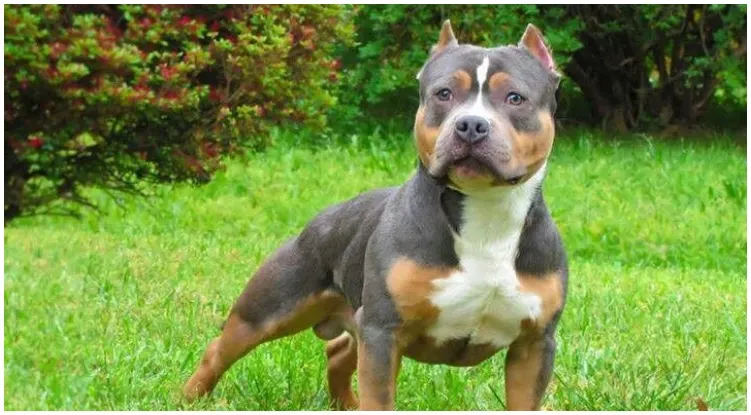Have you ever heard of the tri color Pitbull? It refers to a new color pattern that includes three stunning hues in the American PitBull Terrier. These dogs have a base color that can range from black to lilac. In addition to that, they also have two other shades that are oftentimes tan and white.
However, because of the hype that this dog is getting, breeders found it very exciting to create more color combinations. That’s why tri color Pitbulls are very rare and their genetics a little more complex than the regular dog.
Keep in mind that tri-color Pitbulls will have some white fur on their short coat and the base colors can vary. As we mentioned above, there are not many tri-colored Pitbulls that exist but below are some combinations of the most usual tri-color combinations:
Tri-Color Pitbull Coat Color Genetics
As with everything happening in their bodies, these tri Pitbulls get their coat from genes that they inherit from both parents. What does this mean? This means that the trait is recessive and some of the puppies are likely going to be born without a tri-color coat if one of their parents didn’t possess this specific gene.
Based on the research and according to Animal Genetics, there are four alleles in the Agouti gene series and one of them is the Tan Point allele which is responsible for the tri-color coat pattern.
Breed information about the Pitbull
However, the Tan Point gene must be present to produce a tricolor pattern along with the gene for the base color which can be black, blue, lilac, chocolate, and so on. Last, but not least, the three colors may also be affected by the dilution gene which is responsible for the patterns such as merle or piebald.
If you want this adorable, cute and unique dog to fulfill your home, you should get one. Remember to adopt always instead of buying, if possible!
Tri Color Pitbull Common Health Issues
If you compare it with other dogs, this breed actually has better overall health and less common health issues. Let’s take a list of the most common ones:
- Hip Dysplasia: One of the common problems with dogs suffering from bad genetics. Hip dysplasia represents an unequal rate of growth of their hind legs. The condition may cause pain or difficulty to be an active dog and have a normal life.
- Congenital Heart Disease: Another common cause of tri-color Pitbull death is congenital heart disease. It is detected by irregular heart rhythm. This disease is up to genetics and poor genes where malformations in the heart valves are transferred from generation to generation.
- Hypothyroidism: Symptoms are qutie similar to human hypothyroidism including weight gain, loss of appetite, lethargy, shedding, and cold intolerance. If their thyroid hormones go too low, medications will be given by the vet to treat it properly. The thyroid gland is important since it makes many important hormones for the normal functionality of the dog’s body.
- Cataract: Timing is important here, since if not treated well, it could lead to blindness. Take your tri Pitbull to the vet if its eyes are getting that cloudy look. A vet will usually prescribe eye drops made for dogs as a medical treatment.
Their beautiful colors
When we say tri color Pitbull, we don’t mean there is only one variation. There are many tri-color variations of this breed! And we’ll take a look at all of them.
Lilac Tri-Color Pitbull
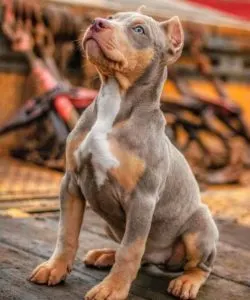
Photo from @enhancedk9 (IG)
We’ll start with the Lilac variation. If you haven’t seen this Pitbull, it has an almost solid lilac coat with smaller patches of tan and white. The white is mostly around her neck, and the area around her paws, snout, ears. While their hind legs have very fine, tan fur.
Black Tri-Color Pitbull
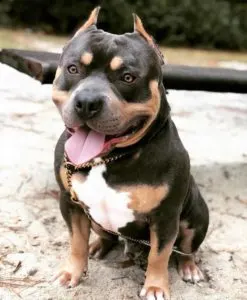
Photo from @musclehead_gates (IG)
The second combination is the Black tri-color Pitbull. Also, this Pittie has an almost solid black coat with two more colors appearing on the area around her neck and on all four legs.
Liver Tri-Color Pitbull
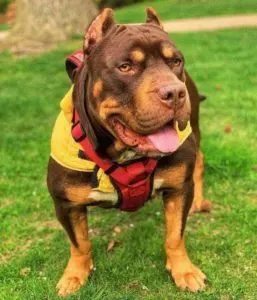
Photo from @gokuthecrybaby (IG)
The third combination is Liver. This Pitbull’s shiny brown unique coat also has different shades. That makes him look like he has more than three colors. You would notice that there are some tan patches on his facial area, a few white spots underneath, and the rest of the tan is on her front and hind legs.
Merle Tri-Color Pitbull
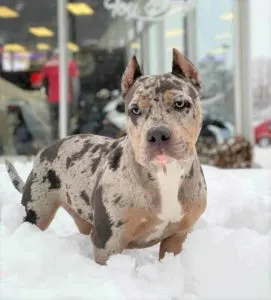
Photo from @cognacbullies (IG)
We came up to the fourth one. Two more to go! Can you guess the color combinations for Pitbull? This merle tricolor Pitbull is a combination of blue merle, fawn, and white. However, the pattern is dramatically painted that when the pup is sitting, you can witness the three colors bursting in his coat.
Blue Tri-Color Pitbull
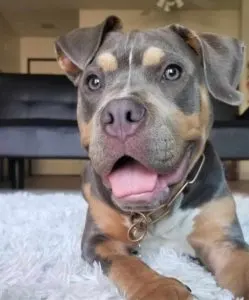
Photo from @cleo_patra17 (IG)
We almost came to an end. One more to go after this one. The advanced feature of this blue three-colored Pitbull is that has a well-balanced color distribution. There is a blue, tan, and white mask covering the paws and the majority of the upper body and the rest of the body is covered in blue fur.
Purple Tri-Color Pitbull
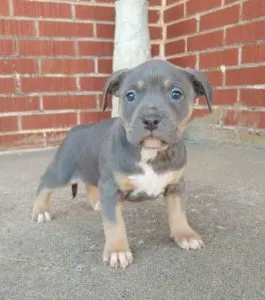
Photo from @oklahomatribullies (IG)
In the end, we’ll shortly describe the purple variation. Their tan color can be seen on the legs as well as a little bit on the snout. While white is seen on the neck area, with the rest of the coat being purple.
Are Tri-Color Pitbulls Recognized by Kennel Clubs?
Unfortunately, neither American Kennel Club nor United Kennel Club recognizes this tri-colored beauty for now. Although you will find some tri-colored breeds there, like Staffordshire Bull Terrier.
As seen also with American Pitbull Terrier, which are banned in the UK, it seems we will have to wait quite some time to get this pitbull breed on the list.
So, for now, do not expect to have them as show dogs, since there are not many (if any) competitions you can participate at the moment.
How Much Does a Tri Pitbull Cost?
Well, you might be a bit surprised but they are not actually thart expensive. You can pay about $750 on average, depending on the puppies parents and genetics, and papers of course.

